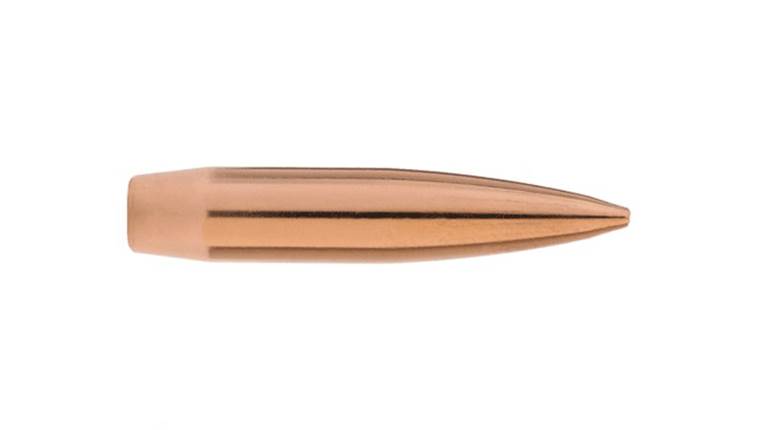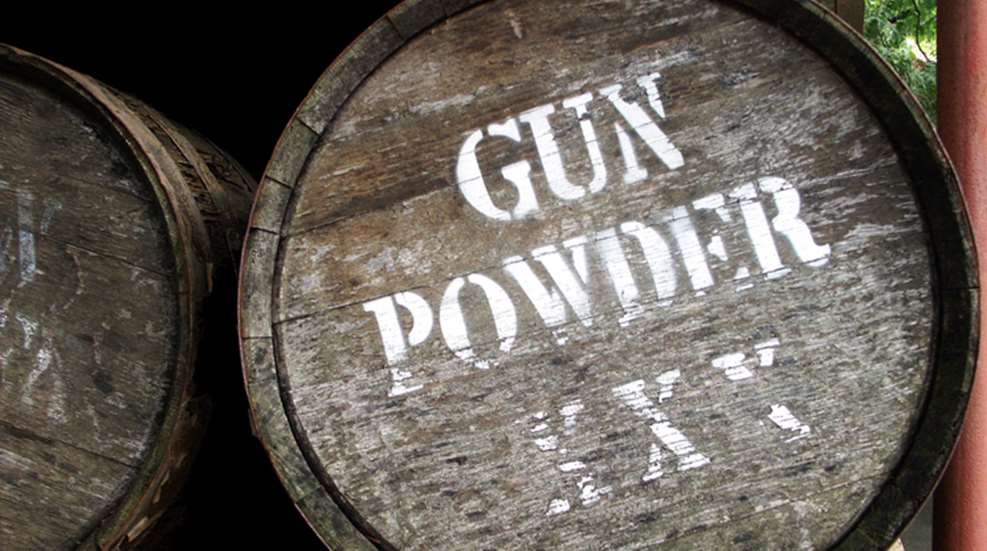
Gunpowder is so fundamental to firearms, it’s amazing that so few know much about it other than it makes a big noise and smells funny. It is the fuel that propels bullets, shot charges or other projectiles.
The first explosive powder—black powder—was invented in China during the 9th century. It is generally accepted that black powder is 75 percent potassium nitrate (salt peter), 15 percent charcoal and 10 percent sulfur. Individual recipes may differ slightly, but this one is the most common. The potassium nitrate acts as an oxidizer; the charcoal and sulfur are fuels. It is considered a low explosive in that it deflagrates at a velocity less than the speed of sound. Black powder deflagrates at a relatively constant rate whether open or confined as in a cartridge case or the chamber of a firearm or cannon. The deflagration rate can be altered slightly by adjusting the size of the kernels or grains of powder. Coarse kernels will burn a slightly slower than fine kernels because they have a smaller surface area exposed to ignition. It contains no chemical accelerants or decelerants to influence its burn rate. 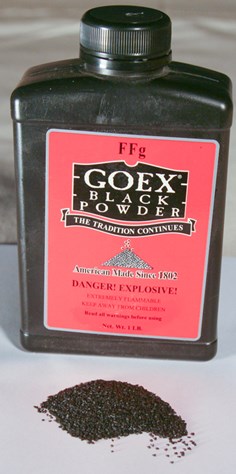
Black powder is characterized by a dense white smoke and a strong, pungent sulfurous odor when ignited. Its report is more like a deep, resonating boom, compared to the “crack” of high-speed modern smokeless powder ammunition. Though largely obsolete in firearms other than replicas for reenactors and certain “black powder only” hunts, it remains in limited use as an explosive in the mining industry, blasting powder, fireworks, as well as a component on large artillery-type weapons. Dynamite and ammonium nitrate/fuel oil mixtures have largely replaced it in the explosives industry. Right: Black powder is identified by its granulation, in this case, FFg, which is used in rifles.
Because of its fouling, which is hydrophilic and corrosive, along with its telltale smoke and what some call an acrid odor, there was a long pursuit of a suitable substitute for black powder as a firearm propellant. A German chemist, Christian Friedrich Schönbein, invented a substance called “guncotton” in 1846. Guncotton is cellulose that has been treated with nitric acid. Cotton was often used as a source of cellulose and after treating and drying in nitric and sulfuric acid, became a product with more explosive power than black powder. As a fuel to launch projectiles, guncotton produced six times the volume of gas than black powder without the smoke and stench of black powder. Unfortunately, it was rather unstable and as likely to blow up a gun as it was to launch a projectile.
Nitroglycerine was synthesized by Italian chemist Ascanio Sobrero in 1847. Although it contains a lot more chemical energy than black powder and it is largely smokeless and sulfur free, nitroglycerine detonates, thus making it wholly unsuitable as a propellant alone.
Several chemists and would-be powder makers continued to research and develop a smokeless and corrosive-free gunpowder. Many perished in laboratory or production facility explosions during the late 1800s. French chemist Paul Vieille invented a smokeless powder called Poudre B (poudre blanche—white powder) made from 68.2-percent nitrocellulose, 29.8-percent nitrocellulose gelatinized with ether and 2-percent paraffin in 1884. This new powder contained 300-percent more energy than an equivalent weight of black powder. It was relatively stable and easy to handle. This powder first saw service in the Lebel rifle.
Austria, France and Germany each began manufacturing of their own versions of Poudre B, and by 1890 smokeless powder had become as prevalent as black powder, especially in sporting arms. England got into the act as well, producing a product called cordite in 1889 and using it in its Mark I and Mark II Enfield rifles chambered in .303 British. Cordite is a double-based powder—meaning that it contains both nitrocellulose and nitroglycerin—and comes in strands resembling spaghetti.
The U.S., not to be left behind, began making versions of smokeless propellants starting with the Anglo-American Explosives Company manufacturing a shotgun powder in Oakland, New Jersey, in 1890. E. I. du Pont de Nemours and Company, more commonly known simply as DuPont started making guncotton at Carneys Point Township, New Jersey, in 1891. Other companies sprang up or got into the powder business as well. Explosive Powders provided Winchester Repeating Arms with powders with which it began its ammunition business. DuPont developed or spun off a number of powder companies including California Powder Works, Hercules and Laffland & Rand.
Like firearms manufacturers, powder companies sought fat government contracts with which they hoped would fill their coffers. But a significant sporting market began to emerge during the first part of the 20th century. Companies lived and died as they experimented with formulas, coatings and granulations of smokeless powders.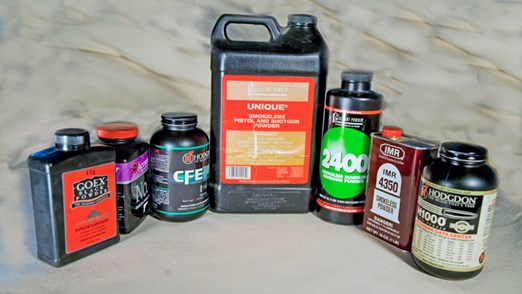
For the average sportsman who uses nothing but factory loaded ammo, powder burn rates are perhaps nice to know and use as a discussion point around the campfire sipping a sundowner, but the handloader—the amateur ballistician—dotes on these characteristics.
Smokeless powders burn differently when they are confined to a case or chamber. So-called faster powders like Hodgdon’s Titewad or Alliant’s Bullseye are fast burning powders with virtually no leftover residue. They achieve their maximum chamber pressure pretty quickly, and it decays just as quickly. These kinds of powders are useful for target shooting in pistols, where light recoil and consistent velocity contribute to accuracy. Moving down the scale to slower powders like Winchester 231, Accurate No. 5 and Ramshot Zip we find powders still useful to the handgunner who is looking for accuracy, perhaps a bit more velocity without undue recoil, as well as the clay bird shotgunner. Moving toward the slower powders Aliant’s Blue Dot, IMR 4227 or Winchester 296 is equally at home in a heavy 12-gauge field load as it is in a .357 Mag. or .44 Mag. revolver. Some of these powders can also be used in small rifle cases like the .22 Hornet or .30 Carbine. For the larger, magnum hunting cartridges, say, .30-06 and above, powders like IMR 4350, H1000 (Hodgdon), Ramshot Big Game or Hodgdon Retumbo is called for. These are among the slowest burning smokeless powders we have. They are designed to spread out the peak chamber pressure over a longer period to allow that pressure to push against the bullet’s base for a longer time and thereby increase its velocity. What I have explained here is the most basic overview of powder burn rates. 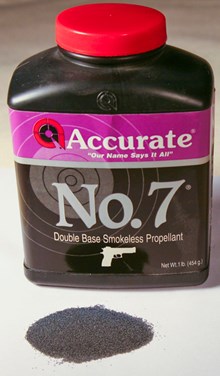
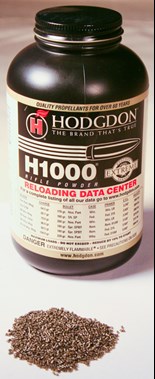
Accurate No. 7 is a spherical, double-based powder suited for moderate pistol loads like the .38 Special. H1000 is a slow-burning, stick powder suited for large capacity rifle cases where a heavy bullet needs to be fired at maximum velocity.
All reloaders should have a current loading manual available from bullet and powder manufacturers. They should stay scrupulously within the parameters give in those manuals. Interestingly, a number of benchrest shooters have learned that a variation of plus-or-minus 2 grains of powder will not have much of an effect on group size. But that does not apply to safety. If the manual says 59.3 grains of a particular powder is the maximum load, don’t try to fudge in an extra half grain or so. Internal ballistics has a nasty habit of forcing you search for fingers and gun parts if you do not heed the manual’s parameters.
Powder technology continues to march forward. We now have copper fouling eliminating powders from Hodgdon (the CFE series) that purportedly reduce the amount of copper fouling a shooter gets in his barrel over a shooting session. Other powders are touted as being designed for a specific cartridge. And, of course, you can go back to old school and shoot black powder—often referred to as “Holy Black” by its adherents—in guns suited for the old stuff. Gunpowder is cool stuff. It can do some wonderful things, but it is a stern mistress and reacts badly toward those who might abuse her rules.












